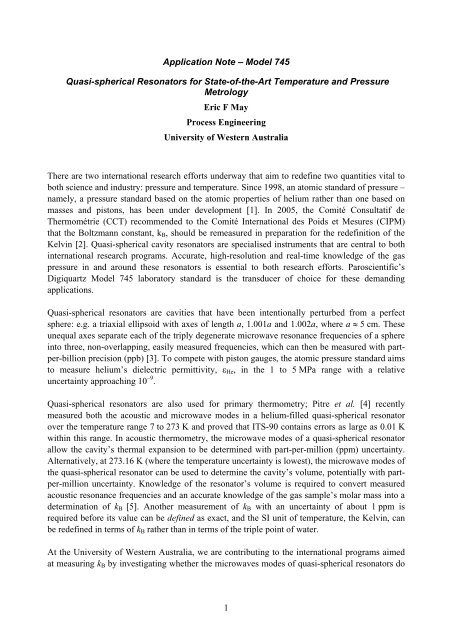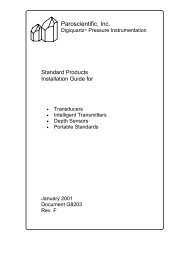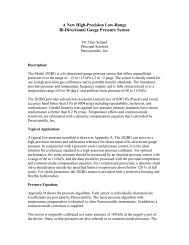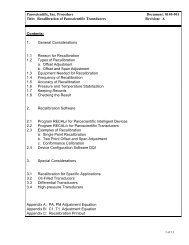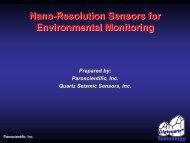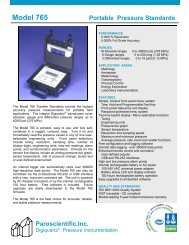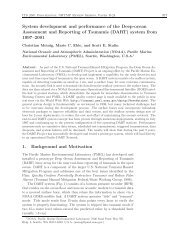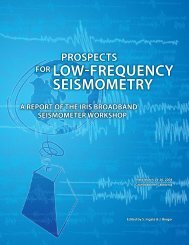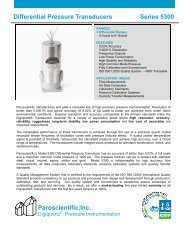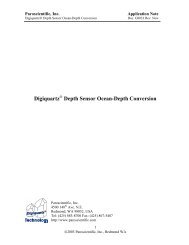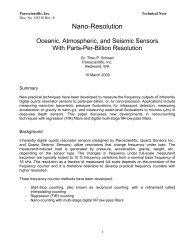1 Application Note â Model 745 Quasi-spherical Resonators for ...
1 Application Note â Model 745 Quasi-spherical Resonators for ...
1 Application Note â Model 745 Quasi-spherical Resonators for ...
Create successful ePaper yourself
Turn your PDF publications into a flip-book with our unique Google optimized e-Paper software.
<strong>Application</strong> <strong>Note</strong> – <strong>Model</strong> <strong>745</strong><strong>Quasi</strong>-<strong>spherical</strong> <strong>Resonators</strong> <strong>for</strong> State-of-the-Art Temperature and PressureMetrologyEric F MayProcess EngineeringUniversity of Western AustraliaThere are two international research ef<strong>for</strong>ts underway that aim to redefine two quantities vital toboth science and industry: pressure and temperature. Since 1998, an atomic standard of pressure –namely, a pressure standard based on the atomic properties of helium rather than one based onmasses and pistons, has been under development [1]. In 2005, the Comité Consultatif deThermométrie (CCT) recommended to the Comité International des Poids et Mesures (CIPM)that the Boltzmann constant, k B , should be remeasured in preparation <strong>for</strong> the redefinition of theKelvin [2]. <strong>Quasi</strong>-<strong>spherical</strong> cavity resonators are specialised instruments that are central to bothinternational research programs. Accurate, high-resolution and real-time knowledge of the gaspressure in and around these resonators is essential to both research ef<strong>for</strong>ts. Paroscientific’sDigiquartz <strong>Model</strong> <strong>745</strong> laboratory standard is the transducer of choice <strong>for</strong> these demandingapplications.<strong>Quasi</strong>-<strong>spherical</strong> resonators are cavities that have been intentionally perturbed from a perfectsphere: e.g. a triaxial ellipsoid with axes of length a, 1.001a and 1.002a, where a ≈ 5 cm. Theseunequal axes separate each of the triply degenerate microwave resonance frequencies of a sphereinto three, non-overlapping, easily measured frequencies, which can then be measured with partper-billionprecision (ppb) [3]. To compete with piston gauges, the atomic pressure standard aimsto measure helium’s dielectric permittivity, ε He , in the 1 to 5 MPa range with a relativeuncertainty approaching 10 –9 .<strong>Quasi</strong>-<strong>spherical</strong> resonators are also used <strong>for</strong> primary thermometry; Pitre et al. [4] recentlymeasured both the acoustic and microwave modes in a helium-filled quasi-<strong>spherical</strong> resonatorover the temperature range 7 to 273 K and proved that ITS-90 contains errors as large as 0.01 Kwithin this range. In acoustic thermometry, the microwave modes of a quasi-<strong>spherical</strong> resonatorallow the cavity’s thermal expansion to be determined with part-per-million (ppm) uncertainty.Alternatively, at 273.16 K (where the temperature uncertainty is lowest), the microwave modes ofthe quasi-<strong>spherical</strong> resonator can be used to determine the cavity’s volume, potentially with partper-millionuncertainty. Knowledge of the resonator’s volume is required to convert measuredacoustic resonance frequencies and an accurate knowledge of the gas sample’s molar mass into adetermination of k B [5]. Another measurement of k B with an uncertainty of about 1 ppm isrequired be<strong>for</strong>e its value can be defined as exact, and the SI unit of temperature, the Kelvin, canbe redefined in terms of k B rather than in terms of the triple point of water.At the University of Western Australia, we are contributing to the international programs aimedat measuring k B by investigating whether the microwaves modes of quasi-<strong>spherical</strong> resonators do1
Photograph of an assembled quasi-sphere including microwave cables.Schematic of a quasi-<strong>spherical</strong> resonator: a ‘race-track’ cavity.3


